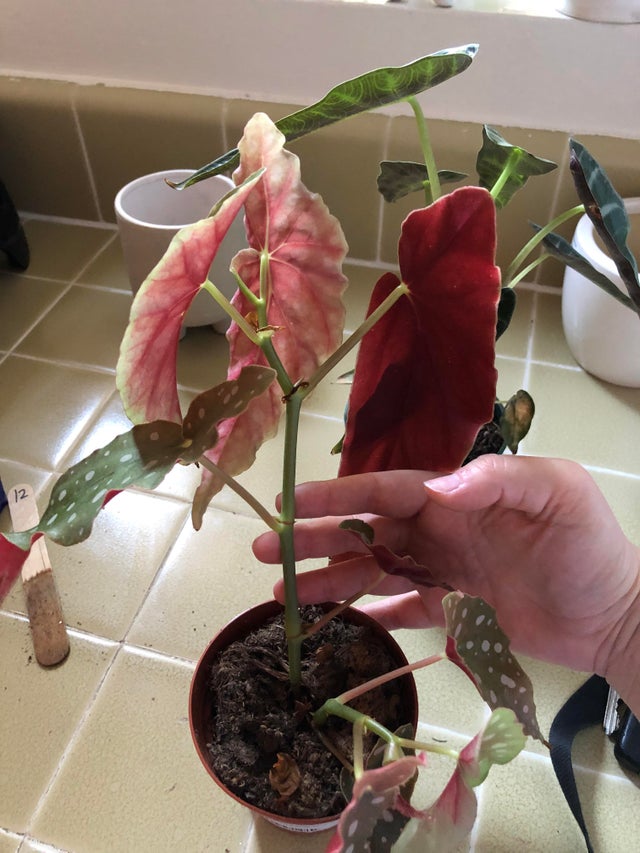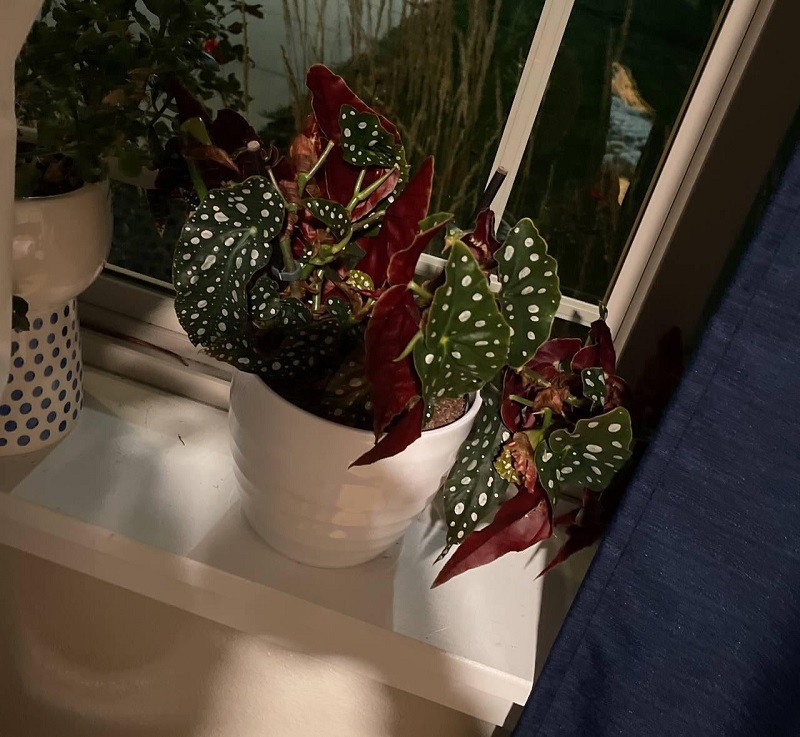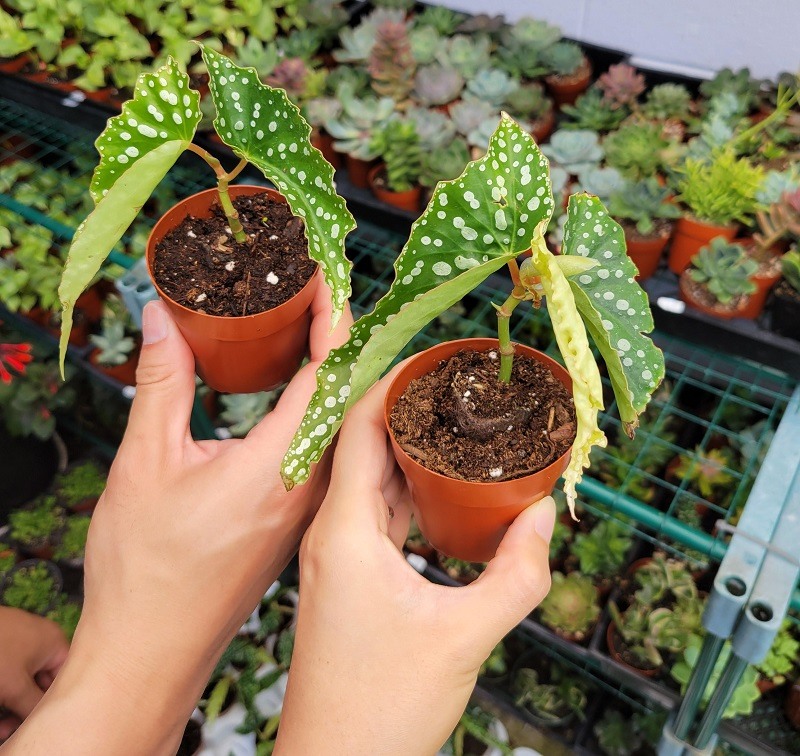Begonia maculata (polka dot plant) is often known as a splashy show-stopper plant. Thanks to its stunning olive green foliages with contrasting spots. The fantastic looks allow the houseplant to mark a bold statement in any space.
Growing and caring for begonia maculata is super easy. The ease of caring makes this indoor plant ideal for beginners. Begonia maculata care indoor is a no-brainer task regardless of your houseplant experience.
Begonia maculata care involves the provision of bright indirect sunlight, well-draining soil, proper watering routines, high humidity, appropriate temperature (65-80oF), and fertilization every 2-4 weeks. Semi-regular pruning is suitable to remove dead leaves.
Keep reading this guide to learn how to care for begonia maculata like a professional. The article also highlights common polka dot plant problems and techniques for fixing them. These ultimate care routines enhance healthy plant growth.
You May Also Like: How to Care for Alocasia Black Velvet
What Does a Polka Dot Plant Look Like?

Begonia maculata belongs to the Begoniaceae family. This begonia variety is also known as wightii, clown, spotted, or polka dot begonia.
The houseplant brings exotic tropical vibes to an office or house. The indoor plant looks like silver polka dots painted on olive-green foliages.
The crimson-colored underside and sprays of open bell-like red or white flowers with bright yellow centers make this begonia species look beautiful.
If you are looking for something unusual that attracts attention, this begonia species is a perfect choice. It is super easy to grow and maintain at home or office.
But this indoor begonia species require specific conditions to thrive. Be sure to provide appropriate humidity, sunlight, temperature, and watering regime.
Below are proven steps for ultimate begonia maculata care indoor to consider. Take the time to read through each requirement topic to enhance better begonia maculata growth.
You May Also Read: How to Care for Mother of Thousands
Begonia Maculata Care Details
| Origin | Southeast Brazil. |
| Family | Begoniaceae. |
| Scientific Name | Begonia Maculata. |
| Common Names | Polka Dot Begonia. Spotted Begonia. Trout Begonia. |
| Light Requirement | Bright Indirect Sunlight. |
| Watering Needs | Moderate Soil Moisture. |
| Soil Texture | Light and Well-Draining. |
| Temperature Requirement | 60-80oF (18-30oC). |
| Fertilizer | Apply Balanced and Water-Soluble Fertilizer Every 2-4 Weeks in Summer and Spring. |
| Humidity Level | High Humidity (Above 45%). |
| Flowering | Spring Season. |
| Pruning | Twice a Year to Remove Dead Leaves and Enhance Compact Shape. |
| Propagation | Stem Cuttings. |
| Re-Potting | Annually in Spring Season. |
| Diseases | Stem and Root Rot. Powdery Mildew. Bacterial Leaf Spot. Botrytis. |
| Pests | Whiteflies. Mealybugs. |
| Toxicity | Poisonous to Pets and Humans. |
| Begonia Maculata Buy | Check Best Deal on Amazon |
How to Care for Begonia Maculata
Begonia Maculata Humidity Requirements
Polka dot plant needs a higher humidity level when compared to other begonia varieties. The average humidity requirement is about 40%.
This houseplant prefers a humidity level of about 90% at night and 70% at daytime. The air moisture enhances the optimal growth and well-being of the plant.
Keep in mind that too much humidity will subject the houseplant to diseases and too little will also cause plant wilting or death.
People living in warmer regions tend to find it easier to grow and care for begonia maculata. Dry climates will force an individual to install an air humidifier to meet the plant’s requirements.
I recommend using a digital hygrometer to monitor indoor humidity levels. Misting the leaves is another excellent alternative to increase humidity around the houseplant.
Begonia maculata is vulnerable to powdery mildew when subjected to high humidity for an extended period. (Source: Colorado State University).
Begonia Maculata Light Requirements
Maculata begonia is a perfect indoor plant since it prefers bright indirect sunlight. Besides that, the houseplant can tolerate low light for a couple of days.
Place the polka dot plant in a position where it receives bright indirect sunlight. Sufficient natural light promotes active growth and flowering.
Excessive exposure to direct sunlight will result in sunburn and wilting. In addition, low light causes thin stems and the production of few flowers.
I recommend using LED Grow Lights when the plant is grown in a dark room. But the houseplant will not thrive well when compared to the one receiving natural light.

Begonia Maculata Soil Requirements
Maculata begonia thrives in light and well-draining potting medium. The potting soil should be rich in organic matter and have a pH range of 6.1 to 7.5.
The potting media is a mixture of sand, perlite, clay, and loam soil. The potting medium tends to mimic the natural habitat of silver-spotted begonias.
Proper air circulation in the soil allows the plant roots to absorb nutrients and thrive. Be sure to use a container with drainage holes to get rid of excess water and prevent waterlogging.
Polka Dot Begonia Water Requirements
Begonia varieties love a regular watering routine. But the plant parent needs to strike the right balance when it comes to watering begonia maculata.
Juvenile maculata loves frequent watering to enhance proper roots development. Be sure to check the soil moisture level before watering the houseplant.
I recommend watering polka dot begonia weekly in summer and less often in winter. A damp soil environment increases the risk of root rot. Get a strict watering schedule.
Dry potting soil may need deep watering to soak it. Ensure the plant pot (Check Best Deals on Amazon) has drainage holes at the bottom to get rid of excess water.
You Can Also Read: How to Care for Oxalis Triangularis
Polka Dot Begonia Temperature Requirement
Polka dot maculata is a tropical rainforest plant that thrives under a temperature range of 65-86oF (18-30oC). But the plant can still survive under average room temperature.
Be sure to keep the houseplant away from drafts and temperature below 59oF (15oC). Begonias are super sensitive to cold and heat.
I recommend using a digital thermometer (Check Best Deals on Amazon) to monitor indoor temperature changes. Ensure the indoor growing conditions mimic their natural habitat.
You Can Also Read: Why Are My Begonia Leaves Turning Brown?
Polka Dot Begonia Flowering
Begonia maculata bloom is white with yellow centers and single stems. Most polka dot plants bloom between spring and fall (autumn).
The flowers have a nice accent that marks a bold statement in any space. Besides that, the fragrance helps to purify indoor air.
If your maculata is not flowering, consider applying fertilizer and providing sufficient bright indirect sunlight. The root-bound issue can also trigger flowering.
Begonia Maculata Pruning
Maculatas are fast-growing houseplants and tend to become leggy over time. The bushy appearance needs pruning intervention to bring an appealing look.
Trim and prune the leggy stems to redirect energy into growing up instead of growing out. Cutting out the tips with a sterilized pruner (Check Best Deals on Amazon) is the best option.
Removal of tips issues hormones that inhibit branching but stimulate bushier growth. The plant remodeling should be done twice a year.
Begonia Maculata Repotting
Polka dot begonia is less vulnerable to root bound, but repotting yearly is highly recommended. Annual soil refreshment facilitates better growth and health in the long run.
Use a top-heavy pot like terracotta when repotting this plant. Be sure to loosen up the roots gently to create space for fresh soil.
Do not use a large pot to avoid excessive use of energy to get nutrients and overwatering issues. I recommend a moderate-size pot.
Begonia Maculata Propagation

Propagating maculata through stem cutting is a no-brainer task. You can put the stems in water or soil to enhance root growth.
Give the plant sufficient light, moisture, and appropriate temperature. It will take about 1-2 weeks for the begonia to get established.
You Can Also Enjoy: 20 Beautiful Hoya Varieties with Names and Pictures
Pests and Diseases
Begonias are more vulnerable to whiteflies and mealybugs. These tiny vampires usually colonize the leaves and stem joints. Apply insecticidal soap spray and oil to eliminate the pests.
Diseases such as bacterial leaf spot, stem rot, botrytis, Powderly mildew, and Pythium root rot are quite dangerous to the houseplant. Treating these fungal diseases is challenging.
Provide ultimate begonia maculata care to prevent fungal diseases. It is the only way to evade the diseases rather than treating.
Common Begonia Maculata Problems and Solutions
Why Are Begonia Maculata Leaves Turning Yellow?
Overwatering stress is the leading cause of begonia maculata leaves turning yellow. Other possible causes are low light, lack of nutrients, cold drafts, diseases, and pest infestation.
Be sure to investigate and identify the exact cause. The reason behind the yellow leaves will help you adopt measures for fixing them before hurting the houseplant.
Why Is My Begonia Maculata Dropping Leaves?
Polka dot plants are temperamental tropical plants. Leaves dropping could be due to low humidity and improper potting medium.
I recommend changing the potting soil and increasing humidity around the plant to avoid leaves dropping issues. Be sure to provide bright indirect sunlight in the long run.
Why Is My Begonia Maculata Dying?
The possible causes are exhausted soil and a damp environment. The excess moisture causes root rot that damages the root system. Damaged roots will no longer absorb nutrients and water.
Consider repotting the plant to fresh potting soil and trimming the mushy roots. Provide ultimate begonia maculata care for faster fixing.
Why Is My Begonia Maculata Falling Over?
Polka dot plants do grow taller and may need little support. Thin stakes and soft ties are the reason behind the maculata falling over.
Insert the stake in a way the direction of the stem leans on it. Be sure to place the ties away from the leaves and flowers to avoid popping them off with ease.
Is Polka Dot Plant Toxic to Humans and Pets?
Begonia maculate contains calcium oxalate in the roots, leaves, and stems. The foliages are slightly toxic though it causes oral irritation.
Begonia roots have more calcium oxalate compounds than other plant parts. Ingestion might cause the death of the cats and dogs. (Sources: ASPCA).
Be sure to keep the houseplant away from toddlers and pets. It is the best way to prevent poisoning your toddler or pets.
You Can Also Read: Why Is My Begonia Wilting?
Final Thoughts
Begonia maculata is relatively easy to grow and care for than other species. Inappropriate begonia maculate care will result in unusual foliage patterns and shapes.
But this polka dot begonia is indoor friendly and easy-going regardless of experience. Ultimate care guarantees happy plants and the production of beautiful flowers.
Polka dot begonia thrives in bright indirect sunlight, average humidity, and temperature range of 60-80oF. Application of liquid fertilizer every two weeks of the growing season is recommendable.
I hope the information in this post will help you grow a healthy and beautiful begonia maculata at home. Strictly follow the above begonia maculate care indoor routines for better results.
